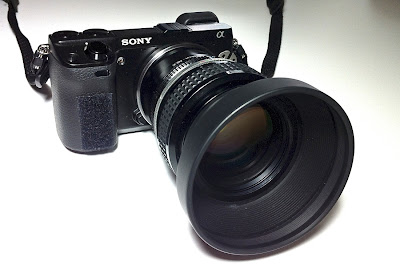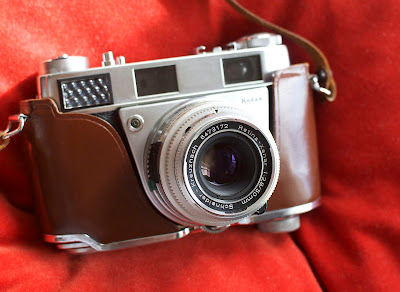This is a post I wrote for my other blog on the VG900 - From the start I'll tell you that the reason for large sensors is simple; DOF and better sensitivity or low light capabilities. For filmmakers it is part of the elusive "film-look" not attainable on small sensor video cameras. If you are interested in where large sensors evolved from, we have to go back in time a little.
I'm going to skim the surface on the development of video camera sensors starting after the invention of the CCD. I won't get into the old tube cameras or the 2 inch Quadruplex videotape. Nor will I get into all the complicated electronics involved. Search the web for this info if you want to go deeper into the rabbit hole.
OK, let's start our journey back in time and begin by going to the movies.
In 1892 George Eastman provided Thomas Edison with 35mm filmstrip with four perforations per frame. By 1909 Eastman Kodak's standard became the international gauge for movie-making - now loosely referred to as Super-35mm.
Oskar Barnack's idea was to take advantage of the newly designed cine film strip and use it in his compact still camera. By 1913 he had developed his prototype. To obtain a larger negative size for his creation he turned the film strip on its side and the Leitz Camera (Leica) was born - commonly referred to as Full Frame 35mm.
Television or video took a different path. Standard video sensors developed for TV had nothing to do with 35mm cine filmstrip, mostly because of the development of the cheaper and more compact 16mm film format, which became the standard film size for early TV production. Before the invention of dedicated video cameras, 16mm film was shot, edited and then transferred to video.
Thanks in part to the extensive use of this smaller film in TV production, manufacturers created the 2/3" CCD sensor for use on video cameras. This innovative sensor was designed for use with c-mount which took advantage of the vast supply of high quality 16mm lenses in use at the time.
 |
| Sony CineAlta F900 - $80,000US |
Professional as well as consumer quality video camcorders were based on TV's analog 525 line NTSC. In the digital realm this translates to 640x480 pixels.
The size of early consumer camcorder sensors was determined by cost - as long as the final image produced 640x480 video with a 4:3 ratio, the sensor could be as small as practical.
By the year 2000 Standard video or SD started giving way to high definition or HD, and sensor size remained the same.
HD cameras developed for professional production, like the groundbreaking $80,000 Sony CineAlta F900, used 2/3" sensors. Sony and other manufacturers were able to fit all the extra pixels and information needed for the larger 1920x1080 HD image into a 2/3" sensor.
Why is the use of large sensors all the rage today? If manufacturers are able to fit more than enough pixels on a 2/3" sensor to make HD video, why make sensors any bigger?

DOF and low-light sensitivity, and because we can. Needless to say, the cost of manufacturing large sensors has come down to reasonable levels.
Now we have to switch back to still photography.
When Kodak invented the first digital camera in 1975 the cost was beyond the common consumer's price-point. By 1995 Kodak's 6 megapixel DCS 460 was selling for over $28,000. The DCS 460 had a relatively large 28mm x 19mm sensor. It was nearly as large as a Full Frame 35mm sensor, and larger than Sony's current Super-35mm, 23.6mm x 13.3mm. The reason?
 |
| Kodak DCS 460 - $28,000US |
Kodak developed their sensors to be used on existing 35mm bodies and lenses, so sensor size had to be as close as possible to Full Frame 35mm as cost would dictate.
Thank you Mr. Oskar Barnack for the development of the 35mm Full Frame format.
As you probably have figured out by now, consumers weren't going to pay over $28,000 for a still camera. The common man had to wait until the development of lower-cost digital still cameras. Sensors for average consumer's would have to be smaller.
As still cameras got better and cheaper to make, manufacturers started adding video capability. At first the video quality was a joke, but as development progressed, and sensors got larger, video quality got increasingly more palatable.
Enter - Jim Jannard, the creative force behind the RED camera. A video camera with a pixel count of 4096x2304 or 4K; much larger than HD's 1920x1080. If it weren't for RED we probably wouldn't be where we are today with large sensor HD filmmaking. Many Hollywood films are now shot in 4K video with RED cameras. These super-35mm cameras are at the forefront of digital cinema production. Checkout some of the films
made on RED. Go visit
RED Digital Cinema for more on RED.
 |
Red One - you can get a stripped
down body for less than $6,000 |
Jim thought, why not use the large Full Frame sensors developed for still cameras on video cameras. This would make video look like film, and if he could use a Super-35mm size sensor with the common PL mount it would allow filmmakers to use the full range of high-end cine lenses already in use in Hollywood. Mind you, the cost for these large sensor video cameras were still beyond the reach of po'folk like me.
Influenced by the success of Red and by Canon's Full Frame 5D still camera, camcorder makers like Sony, Panasonic, and others are now finally marketing the next generation of camcorders with larger sensors at much more benign prices. The elusive "film-look" with extreme narrow depth of field is now attainable by independent filmmakers at reasonable costs.
 |
| Sony NEX-VG900 |
Sony's latest release, the NEX-VG900 camcorder with a Full Frame 35mm 24.3MP sensor, sells for under $3300.
Canon, Panasonic, Sony as well as other manufacturers have released interchangeable lens, large sensor camcorders in recent months. They are counting on people like us to keep making digital films.
I purchased a VG900 and you can see a video I shot with it in my Post Above.
FEB. 2015 UPDATE:
Sony has introduced a mirrorless digital camera that shoots 4K Video - see my blog
4KProducer













































